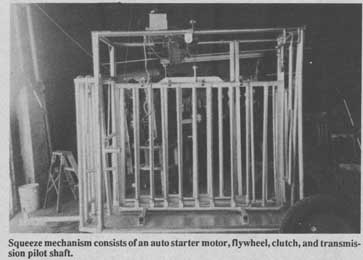
"Lets even a child handle the largest cattle," says Keith Lamb, Gruver, Texas, about his first-of-its-kind electric squeeze chute that eliminates the effort needed to run manual chutes and costs much less than all-hydraulic chutes.
Lamb got the idea for his chute in an effort to reduce the labor required to work cattle. Many of the "hired hands" available in his area are women and teenagers who often have trouble operating manual chutes. "There's also a real hazard of the squeeze bar shaking loose and hitting people. It happens all the time," he says.
So Lamb replaced the manual lever with a positive ratchet driven by an automotive starter motor. An ordinary 12-volt battery provides power so the chute is totally portable. To squeeze the chute you just push a button. If the battery wears down, or if you don't want to puta battery on the chute, you can just hook up to your pickup or tractor battery with jumper cables," he says.
The squeeze mechanism consists of an auto starter motor, flywheel, clutch and transmission pilot shaft. A single touch of a button rotates the shaft 60 degrees. A safety slip clutch stops the rotation on big animals once they're squeezed tight enough.
To "unsqueeze" the chute you just pull a lever that releases the ratchet dog.
"Hydraulic chutes work well but require 220-volt power to operate so you can't just take them anywhere. As far as I know, there's not another electric chute on the market like this one," says Lamb, whose prototype chute mounts on a 2-wheel trailer.
The drive system is designed so that if power ever failed, the chute can still be operated manually. Lamb has also come up with a new rear gate that's designed to replace existing sliding gates that raise up and down by rope. His new gate is split down the middle. A single lever pivots both sides of the gate outward, making it much easier to open and shut.
Lamb says his electric power kit can be adapted to most existing chutes. He converts chutes using salvaged parts. "It's a lot cheaper than the what you'd spend for a hydraulic chute," he says. He plans to develop a do-it-yourself bolt-on kit. He'd like to sell the powered chute idea, on which he has patent pending, to a manufacturer.
